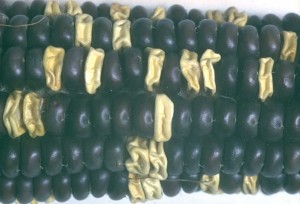Arabidopsis that carries broken copies of both the AP1 (apetala1) and CAL (cauliflower) genes. The flower bearing stems have been replaced by these cauliflower-head-like growths. Image from "Genome-Wide Analysis of Gene Expression during Early Arabidopsis Flower Development" by Frank Wellmer et al (in PLOS Genetics a creative commons licensed journal). Article here: http://dx.doi.org/doi:10.1371/journal.pgen.0020117
Just in time for me to put together my worksheet for Thursday! I’ve managed to work in the CAL gene, which I talked about last week in my discussion of Cruciferous vegetables:
Cauliflower plants (and broccoflower plants) have broken copies of the CAL gene, which (when it isn’t broken) is helps the plant decide to switch from producing stems that were bear flowers to the flowers themselves. Without a functional version of CAL, cauliflowers just keep making denser and denser stems, producing the distinctive heads of cauliflower. If you have journal access, you can read more about the CAL gene at this science paper: http://dx.doi.org/10.1126/science.7824951
I also threw in a question that uses the shrunken2 gene (one of the two most common genes that convert normal starchy corn into sweet corn). From the question in question:

Note the shriveling of the yellow kernels that carry two broken copies of the shrunken2 gene, the purple kernels carry either one broken and one working copy of shrunken2, or two working copies. The change in color is controlled by another gene nearby on the same chromosome, shrunken2 itself has no effect on the color of corn kernels. Photo credit goes to MG Neuffer and MaizeGDB.
Corn kernels without a working copy of the shrunken2 gene can’t convert very much of the sugar provided by photosynthesis in the leaves of the corn plant into starch. Instead, sugar itself accumulates in the kernel making the corn taste quite sweet.
When sugary corn kernels are dried, they shrivel up, while starchy ones remain relatively round and smooth. This has to do with the fact that sugars are water soluble while starch is not. So, as I understand it, corn kernels with more sugar are also a greater percentage water than corn kernels that are made mostly of starch.
The mutant form of shrunken2 was identified by John Laughnan, a maize geneticist at the University of Illinois Urbana-Champaign. The story of the discovery as told in Maize Genetics and Breeding in the 20th Century by Peter Peterson and Angelo Bianchi: (more…)